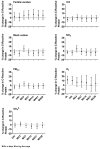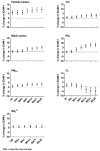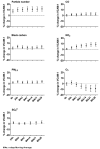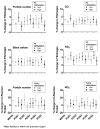Air pollution and markers of coagulation, inflammation, and endothelial function: associations and epigene-environment interactions in an elderly cohort
- PMID: 22237295
- PMCID: PMC3285258
- DOI: 10.1097/EDE.0b013e31824523f0
Air pollution and markers of coagulation, inflammation, and endothelial function: associations and epigene-environment interactions in an elderly cohort
Abstract
Background: Previous studies suggest that air pollution is related to thrombosis, inflammation, and endothelial dysfunction. Mechanisms and sources of susceptibility are still unclear. One possibility is that these associations can be modified by DNA methylation states.
Methods: We conducted a cohort study with repeated measurements of fibrinogen, C-reactive protein, intercellular adhesion molecule-1 (ICAM-1), and vascular cell adhesion molecule-1 (VCAM-1) in 704 elderly men participating in the Veterans Administration Normative Aging Study (2000-2009). We investigated short- and intermediate-term air pollution effects on these blood markers, and epigene-environment interactions by DNA methylation of Alu, LINE-1, tissue factor (F3), Toll-like receptor 2 (TLR-2), and ICAM-1.
Results: We found effects of particle number, black carbon, nitrogen dioxide (NO(2)), and carbon monoxide (CO) on fibrinogen. Ozone was a predictor of C-reactive protein and ICAM-1. Particle number, black carbon, NO(2), CO, PM(2.5), and sulfates were associated with ICAM-1 and VCAM-1. An interquartile range increase in 24-hour exposure for NO(2) was associated with a 1.7% (95% confidence interval = 0.2%-3.3%) increase in fibrinogen for ozone; a 10.8% (2.2%-20.0%) increase in C-reactive protein for particle number; a 5.9% (3.6%-8.3%) increase in ICAM-1; and for PM(2.5), a 3.7% (1.7%-5.8%) increase in VCAM-1. The air pollution effect was stronger among subjects having higher Alu, lower LINE-1, tissue factor, or TLR-2 methylation status.
Conclusion: We observed associations of traffic-related pollutants on fibrinogen, and both traffic and secondary particles on C-reactive protein, ICAM-1, and VCAM-1. There was effect modification by DNA methylation status, indicating that epigenetic states can convey susceptibility to air pollution.
Figures






Similar articles
-
Long-term exposure to air pollution and markers of inflammation, coagulation, and endothelial activation: a repeat-measures analysis in the Multi-Ethnic Study of Atherosclerosis (MESA).Epidemiology. 2015 May;26(3):310-20. doi: 10.1097/EDE.0000000000000267. Epidemiology. 2015. PMID: 25710246 Free PMC article.
-
Air pollution and gene-specific methylation in the Normative Aging Study: association, effect modification, and mediation analysis.Epigenetics. 2014 Mar;9(3):448-58. doi: 10.4161/epi.27584. Epub 2014 Jan 2. Epigenetics. 2014. PMID: 24385016 Free PMC article.
-
A novel genetic score approach using instruments to investigate interactions between pathways and environment: application to air pollution.PLoS One. 2014 Apr 22;9(4):e96000. doi: 10.1371/journal.pone.0096000. eCollection 2014. PLoS One. 2014. PMID: 24755831 Free PMC article.
-
The effect of nuts on inflammation.Asia Pac J Clin Nutr. 2008;17 Suppl 1:333-6. Asia Pac J Clin Nutr. 2008. PMID: 18296371 Review.
-
The Impact of Air Pollution on Our Epigenome: How Far Is the Evidence? (A Systematic Review).Curr Environ Health Rep. 2018 Dec;5(4):544-578. doi: 10.1007/s40572-018-0218-8. Curr Environ Health Rep. 2018. PMID: 30361985
Cited by
-
Modifiable contributing factors to COVID-19: A comprehensive review.Food Chem Toxicol. 2023 Jan;171:113511. doi: 10.1016/j.fct.2022.113511. Epub 2022 Nov 28. Food Chem Toxicol. 2023. PMID: 36450305 Free PMC article. Review.
-
The relation between past exposure to fine particulate air pollution and prevalent anxiety: observational cohort study.BMJ. 2015 Mar 24;350:h1111. doi: 10.1136/bmj.h1111. BMJ. 2015. PMID: 25810495 Free PMC article.
-
Exploring spatiotemporal pattern in the association between short-term exposure to fine particulate matter and COVID-19 incidence in the continental United States: a Leroux-conditional-autoregression-based strategy.Front Public Health. 2023 Dec 22;11:1308775. doi: 10.3389/fpubh.2023.1308775. eCollection 2023. Front Public Health. 2023. PMID: 38186711 Free PMC article.
-
Sex Associations Between Air Pollution and Estimated Atherosclerotic Cardiovascular Disease Risk Determination.Int J Public Health. 2023 Sep 28;68:1606328. doi: 10.3389/ijph.2023.1606328. eCollection 2023. Int J Public Health. 2023. PMID: 37841972 Free PMC article.
-
To breathe or not to breathe: negative data on ozone and vascular function in an established research model.Toxicol Sci. 2013 Oct;135(2):263-4. doi: 10.1093/toxsci/kft169. Toxicol Sci. 2013. PMID: 24158039 Free PMC article. No abstract available.
References
-
- Brook RD, Rajagopalan S, Pope CA, 3rd, et al. Particulate matter air pollution and cardiovascular disease: An update to the scientific statement from the American Heart Association. Circulation. 2010;121:2331–78. - PubMed
-
- Danesh J, Collins R, Appleby P, Peto R. Association of fibrinogen, C-reactive protein, albumin, or leukocyte count with coronary heart disease: meta-analyses of prospective studies. JAMA. 1998;279:1477–82. - PubMed
-
- Peters A, Doring A, Wichmann HE, Koenig W. Increased plasma viscosity during an air pollution episode: a link to mortality? Lancet. 1997;349:1582–7. - PubMed
-
- Zeka A, Sullivan JR, Vokonas PS, Sparrow D, Schwartz J. Inflammatory markers and particulate air pollution: characterizing the pathway to disease. Int J Epidemiol. 2006;35:1347–54. - PubMed
Publication types
MeSH terms
Substances
Grants and funding
LinkOut - more resources
Full Text Sources
Medical
Research Materials
Miscellaneous

